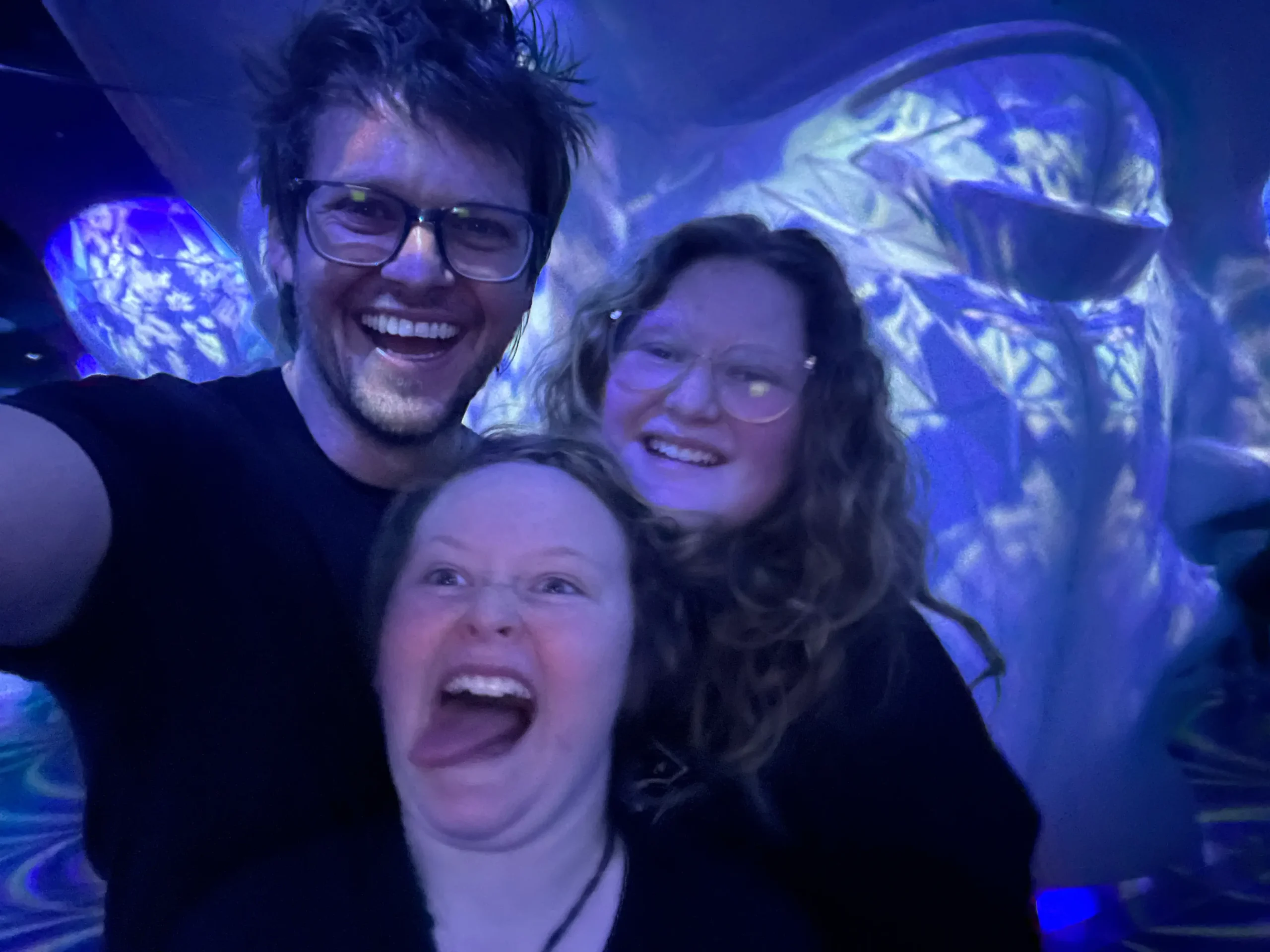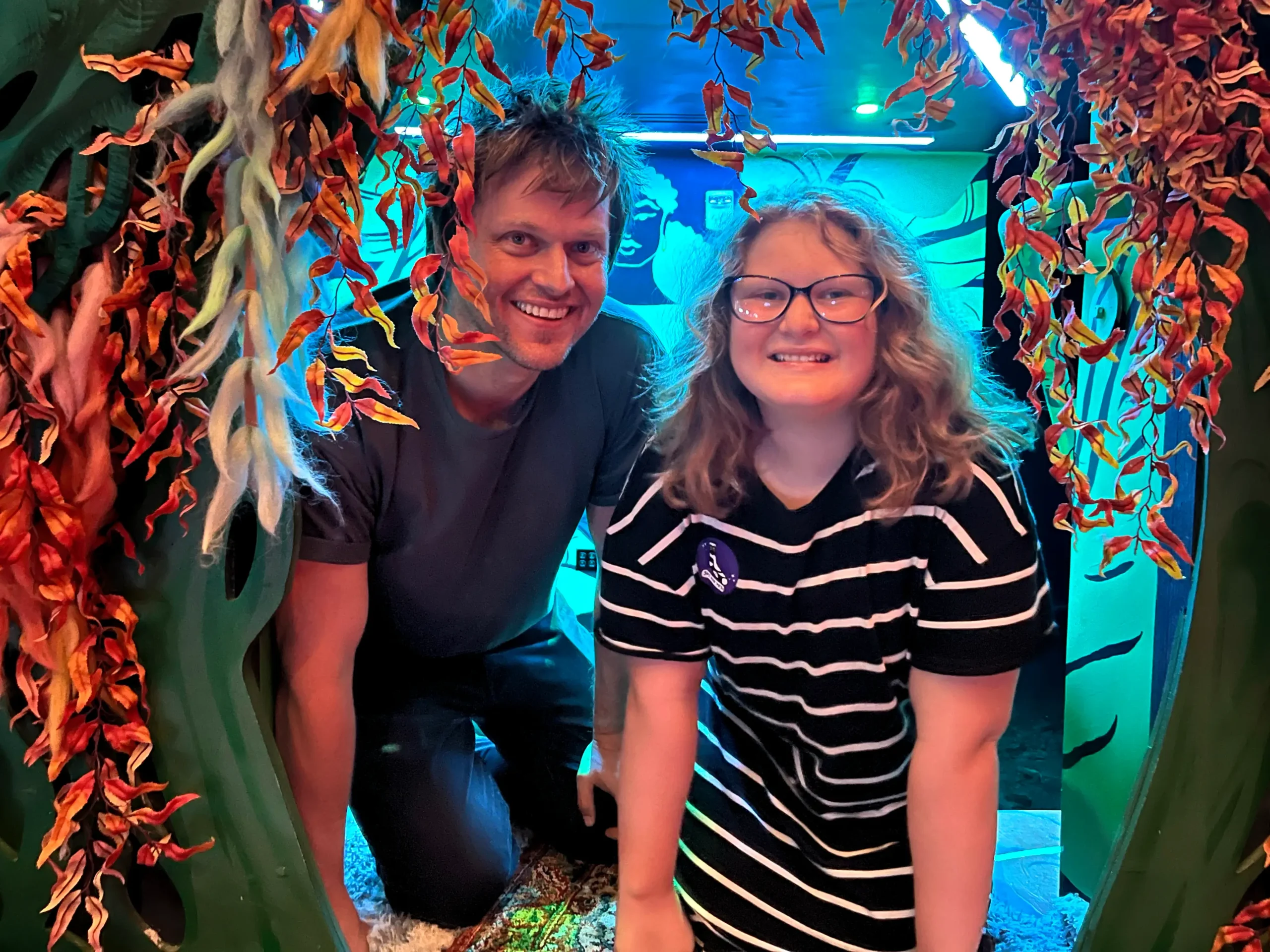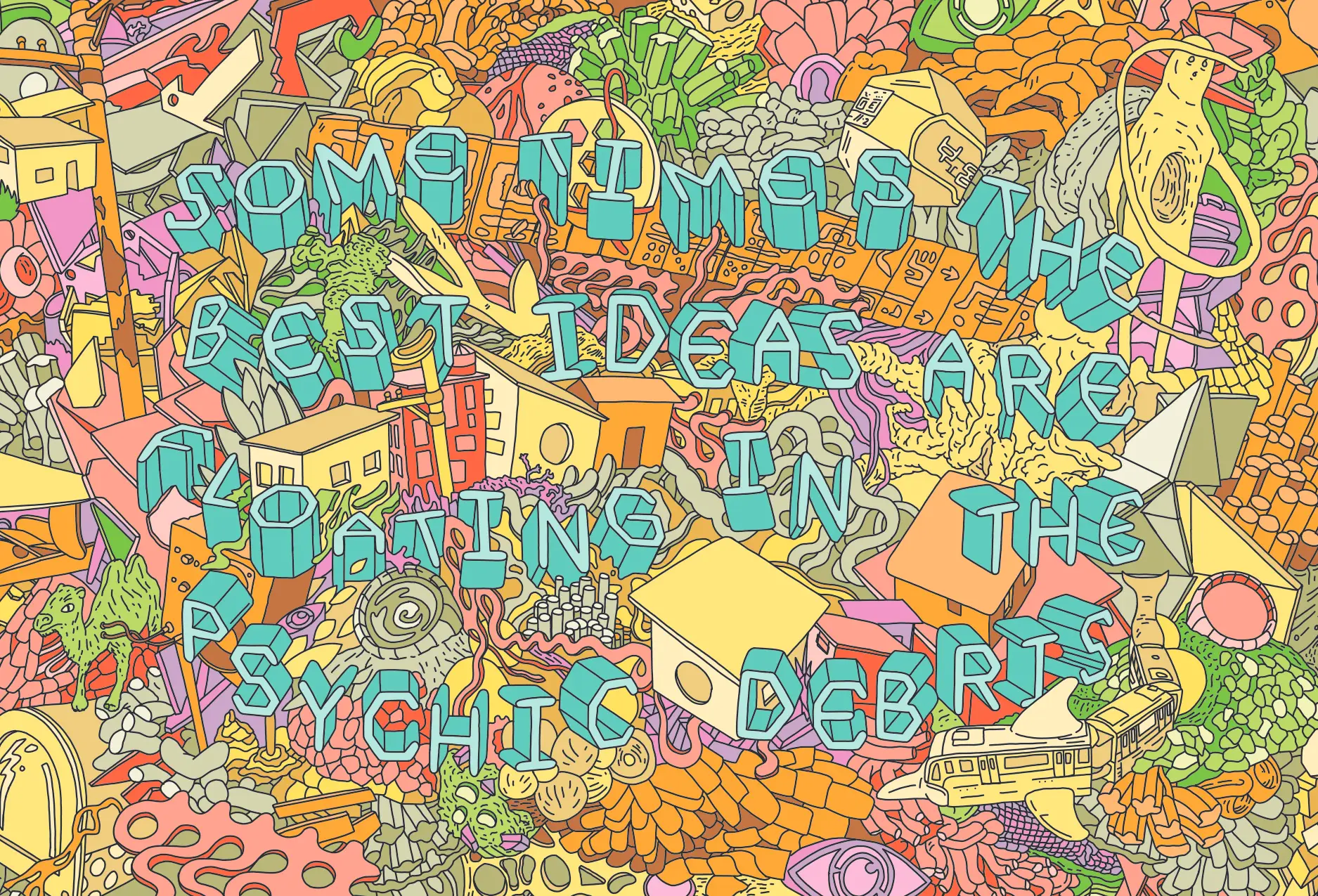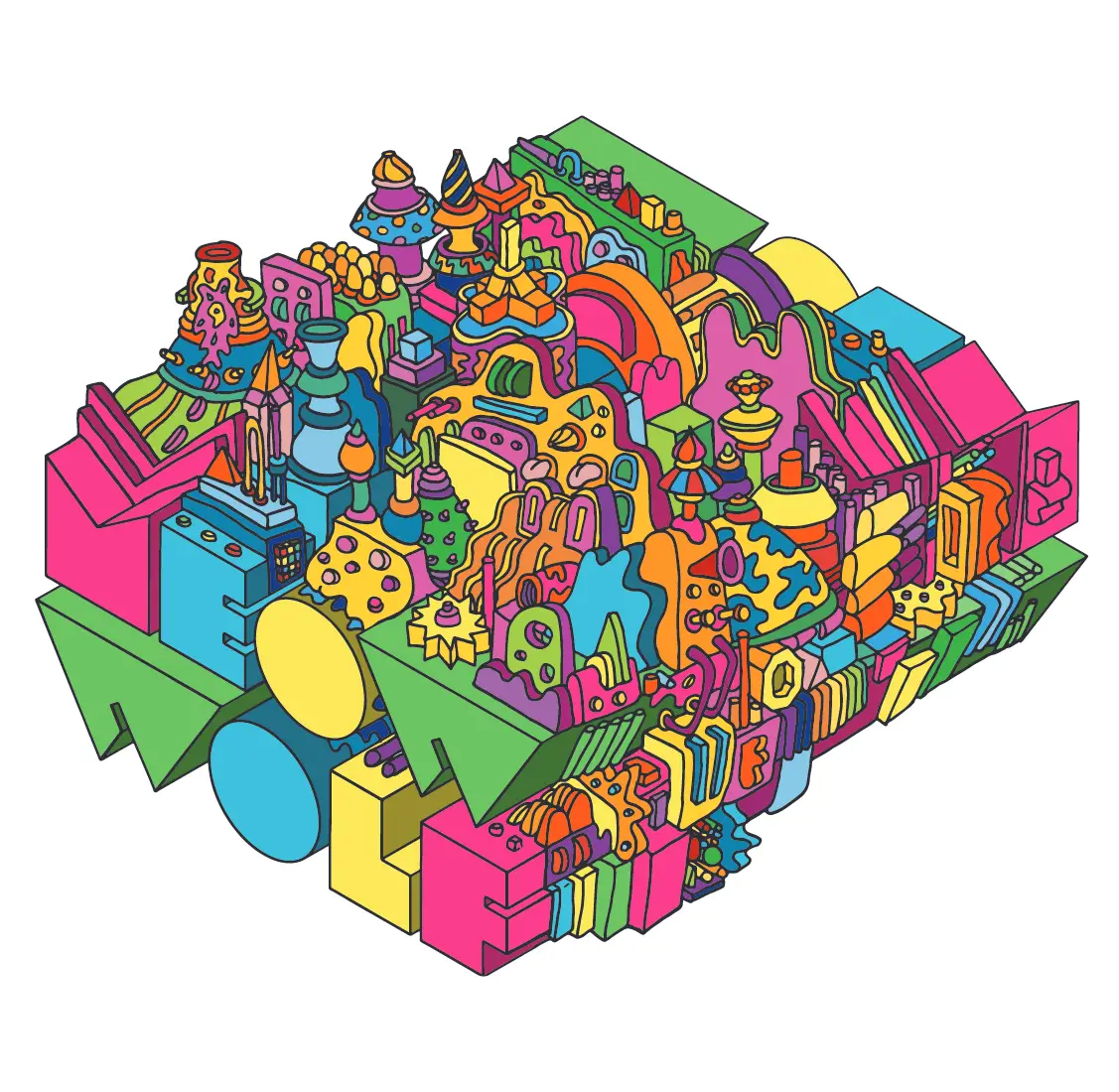Courtesy artwork: One of Dorman’s most recognizable designs for Meow Wolf.
How creativity and imagination can take shape in our lives and with our families
By Luke Dorman
It’s an understatement to say that I was excited when I joined Santa Fe’s immersive art luminaries, Meow Wolf, in 2018. For a decade or so, I’d watched the collective slowly transform from a scrappy band of artists hosting art shows and parties in a warehouse, to a more mature and ambitious group building increasingly grand and complex installations around Santa Fe. They had reached a crescendo, at that point, with the opening of the House of Eternal Return in 2016; an experience that had become a frequent weekend activity for me and my two children.
Our annual pass allowed us to sometimes stop by on a whim and wander the exhibition, while other times we’d skip the exhibition altogether and go straight to making art in the learning center (now called Rainbow Rainbow). Meow Wolf was a special place for us, so I was understandably thrilled to be able to contribute to something that felt so meaningful to me and my kids.
What I believed then, and still believe now, is that there’s immense transformative power in creating and experiencing art, in all its varied forms. I believe that art-making is a force for good, and I believe that creating art, of any sort, is an act of hope. I think that the creative act helps us recognize our ability to contribute to and shape the world around us, well beyond the specific art we are creating at that moment. When we have meaningful experiences with someone else’s art it helps us recognize one of the best parts of our humanity: Our instinct to create and shape the world around us to (ideally) become a better place. The acknowledgement of our innate creative impulse is at the core of the inspiration we feel from moving art experiences—it’s a reminder that the ability to create isn’t reserved for a select few, it’s something accessible to all of us.

Courtesy photo: The author and his kids, Bella and Cleo, during a visit to Omega Mart in 2024.
For example: I remember the first time I stood in the canopy of the forest at the House of Eternal Return and noticed that the leaves of all the trees were made of cut paper. I marveled at the idea that someone actually cut this massive amount of paper and strung it together in an absurd and possibly heroic act of patience and perseverance. To spend so much time and energy on something that could go unnoticed, all for the sake of creative expression—to work so tirelessly on one beautiful moment inside 20,000 square feet densely packed with beautiful moments—I found that truly inspiring. In this moment I also saw how accessible creativity can be. This moment didn’t succeed because of some special artistic prowess, it wasn’t the result of years of study in artistic techniques. It was the result of a creative vision followed up with dedication—two things that are accessible to everyone.
What I also appreciated about this moment and, by extension, what I appreciated about the entirety of the House of Eternal Return is that in the face of all the choices we have for how we use our time, the artists who built the exhibition chose to spend their time making something beautiful. The fact that a hundred or so people collectively chose to create rather than consume —to build a piece of the world that they wanted to see exist, was incredibly impactful and inspirational to me. This inspiration was deepened through a recognition that Meow Wolf wasn’t built by an individual, but was built by a community. It speaks to the importance of being able to work together to achieve things you cannot do on your own and, as illustrator John Kascht said recently, “Working through differences towards a common purpose is practically an act of defiance these days.”
In one of my favorite books, Art and Fear by David Bayles and Ted Orland, they write that “You make your place in the world by making part of it—by contributing some new part to the set…. Each new piece of your art enlarges our reality. The world is not done yet.” This is where I see a connection between my passion for art and my duty as a parent. I not only have a desire, for myself, to help contribute to building a better world for my kids, but I also want to teach them that they have an ability and obligation to do the same. The world is not done yet—they, too, will help shape the world through their own contributions, and so it’s important that my kids see and understand that what we put into the world matters.

Courtesy photo: The author and his oldest child, Bella, at The Real Unreal.
So much of what we do, whether we recognize it or not, builds the future—either by maintaining the status quo, or by imagining something new. The lesson of Meow Wolf is that we build worlds, and so it’s imperative that the worlds we build are ones we want to be a part of. Of course, Meow Wolf’s creations are temporary respites from the “real” world, but it’s an important example nonetheless since the immersive spaces we create represent a world we want to inhabit. We work hard to create spaces that manifest the things we care about, and the recognition of our ability to do this in our everyday lives is something I want to pass along to my children.
Art, as a creative act, is an empowering activity. While the transformation of a stack of paper to a full sized tree canopy cannot be done in an afternoon, the transformation of a blank piece of canvas to a colorful landscape can be done with much more ease. At the core of art-making is a transformative way of looking at the world—to see that paper can be leaves, that cardboard can be boulders, that steel can be a tree, that a refrigerator can be a portal, that paint can be magic. The tasks our kids will undergo to manifest what they care about through the rest of their lives will likely be more of a challenge than these artful transformations, but the lessons they can learn through art-making root them in the ability we all have to transform the world around us. All of what we do—from the way we treat the people in our lives, the way we show up for others, the way we care for our planet, etc. all helps create the world. It’s important that we create a world we want to be a part of.
I hope that my work with Meow Wolf has helped serve as an example, for my kids, of what can be accomplished when a whole lot of people work together to do something improbable and bring a vision of a fantastical world into reality. I hope to teach them, through the creative act, that great things can happen when we work together with our community, that beauty exists even if sometimes we have to work hard for it, and that we all have an ability to make a future that we want to see, even if it starts with a pair of scissors and a whole lot of paper.

Courtesy artwork: One of Dorman’s drawings for Meow Wolf.
Luke Dorman is the principal graphic designer at Meow Wolf, a Santa Fe arts and entertainment company. At Meow Wolf, Dorman leads design teams in the creation of immersive, interactive narrative experiences that transport audiences of all ages into fantastic realms of story and exploration. Dorman also maintains an independent creative practice focused on design and illustration, creating poster designs for clients like Animal Collective, the Telluride Film Festival, and Red Wing Roots Music Festival. Prior to joining Meow Wolf, Dorman worked in design education and carries his passion for teaching, mentorship, and community building into his work today.


